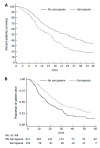Role of frailty and sarcopenia in predicting outcomes among patients undergoing gastrointestinal surgery
- PMID: 26843911
- PMCID: PMC4724585
- DOI: 10.4240/wjgs.v8.i1.27
Role of frailty and sarcopenia in predicting outcomes among patients undergoing gastrointestinal surgery
Abstract
According to the United States census bureau 20% of Americans will be older than 65 years in 2030 and half of them will need an operation - equating to about 36 million older surgical patients. Older adults are prone to complications during gastrointestinal cancer treatment and therefore may need to undergo special pretreatment assessments that incorporate frailty and sarcopenia assessments. A focused, structured literature review on PubMed and Google Scholar was performed to identify primary research articles, review articles, as well as practice guidelines on frailty and sarcopenia among patients undergoing gastrointestinal surgery. The initial search identified 450 articles; after eliminating duplicates, reports that did not include surgical patients, case series, as well as case reports, 42 publications on the impact of frailty and/or sarcopenia on outcome of patients undergoing gastrointestinal surgery were included. Frailty is defined as a clinically recognizable state of increased vulnerability to physiologic stressors resulting from aging. Frailty is associated with a decline in physiologic reserve and function across multiple physiologic systems. Sarcopenia is a syndrome characterized by progressive and generalized loss of skeletal muscle mass and strength. Unlike cachexia, which is typically associated with weight loss due to chemotherapy or a general malignancy-related cachexia syndrome, sarcopenia relates to muscle mass rather than simply weight. As such, while weight reflects nutritional status, sarcopenia - the loss of muscle mass - is a more accurate and quantitative global marker of frailty. While chronologic age is an important element in assessing a patient's peri-operative risk, physiologic age is a more important determinant of outcomes. Geriatric assessment tools are important components of the pre-operative work-up and can help identify patients who suffer from frailty. Such data are important, as frailty and sarcopenia have repeatedly been demonstrated among the strongest predictors of both short- and long-term outcome following complicated surgical procedures such as esophageal, gastric, colorectal, and hepato-pancreatico-biliary resections.
Keywords: Frailty; Morbidity; Mortality; Outcomes; Sarcopenia.
Figures




Similar articles
-
Association of Postoperative Clinical Outcomes With Sarcopenia, Frailty, and Nutritional Status in Older Patients With Colorectal Cancer: Protocol for a Prospective Cohort Study.JMIR Res Protoc. 2021 Aug 17;10(8):e16846. doi: 10.2196/16846. JMIR Res Protoc. 2021. PMID: 34402798 Free PMC article.
-
The Long Winding Road to Transplant: How Sarcopenia and Debility Impact Morbidity and Mortality on the Waitlist.Clin Gastroenterol Hepatol. 2017 Oct;15(10):1492-1497. doi: 10.1016/j.cgh.2017.04.004. Epub 2017 Apr 8. Clin Gastroenterol Hepatol. 2017. PMID: 28400317 Review.
-
Impact of frailty and ultrasonography-based sarcopenia on the development of postoperative complications in gastrointestinal cancer patients.Turk J Med Sci. 2021 Jun 28;51(3):1261-1266. doi: 10.3906/sag-2012-242. Turk J Med Sci. 2021. PMID: 33631869 Free PMC article.
-
The prevalence of sarcopenia and cachexia in older patients with localized colorectal cancer.J Geriatr Oncol. 2023 Jan;14(1):101402. doi: 10.1016/j.jgo.2022.11.001. Epub 2022 Nov 21. J Geriatr Oncol. 2023. PMID: 36424269 Clinical Trial.
-
Ageing well: a review of sarcopenia and frailty.Proc Nutr Soc. 2015 Nov;74(4):337-47. doi: 10.1017/S0029665115002037. Epub 2015 May 25. Proc Nutr Soc. 2015. PMID: 26004622 Review.
Cited by
-
The impact of sarcopenia on the postoperative outcome in colorectal cancer surgery.Med Pharm Rep. 2023 Jan;96(1):20-27. doi: 10.15386/mpr-2483. Epub 2023 Jan 25. Med Pharm Rep. 2023. PMID: 36818326 Free PMC article. Review.
-
Pre-operative Sarcopenia Identifies Patients at Risk for Poor Survival After Resection of Biliary Tract Cancers.J Gastrointest Surg. 2018 Oct;22(10):1697-1708. doi: 10.1007/s11605-018-3802-1. Epub 2018 May 31. J Gastrointest Surg. 2018. PMID: 29855867
-
Clinical implications of low skeletal muscle mass in early-stage breast and colorectal cancer.Proc Nutr Soc. 2018 Nov;77(4):382-387. doi: 10.1017/S0029665118000423. Epub 2018 Jun 4. Proc Nutr Soc. 2018. PMID: 29860952 Free PMC article. Review.
-
Long-term impact of sarcopenia in older patients undergoing gastrectomy for gastric cancer: a systematic review and meta-analysis.Transl Gastroenterol Hepatol. 2023 Oct 26;8:35. doi: 10.21037/tgh-23-34. eCollection 2023. Transl Gastroenterol Hepatol. 2023. PMID: 38021358 Free PMC article.
-
Effect of Sarcopenia on the Increase in Liver Volume and Function After Portal Vein Embolization.Cardiovasc Intervent Radiol. 2024 May;47(5):642-649. doi: 10.1007/s00270-024-03676-2. Epub 2024 Feb 28. Cardiovasc Intervent Radiol. 2024. PMID: 38416177 Free PMC article.
References
-
- Blackwell DL, Lucas JW, Clarke TC. Summary health statistics for U.S. adults: national health interview survey, 2012. Vital Health Stat 10. 2014;(260):1–161. - PubMed
-
- Colloca G, Santoro M, Gambassi G. Age-related physiologic changes and perioperative management of elderly patients. Surg Oncol. 2010;19:124–130. - PubMed
-
- Sawhney R, Sehl M, Naeim A. Physiologic aspects of aging: impact on cancer management and decision making, part I. Cancer J. 2005;11:449–460. - PubMed
Publication types
LinkOut - more resources
Full Text Sources
Other Literature Sources
Research Materials

